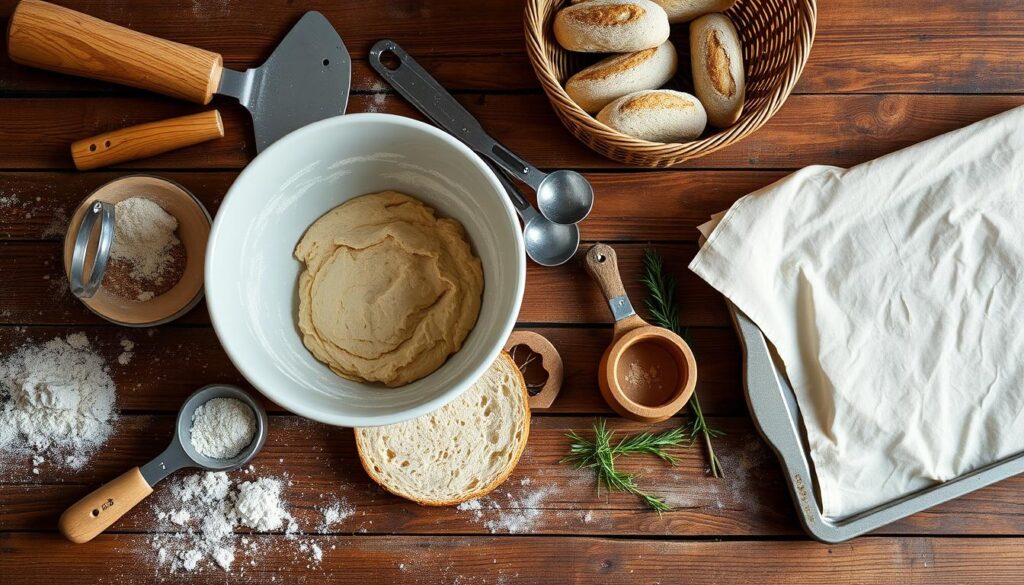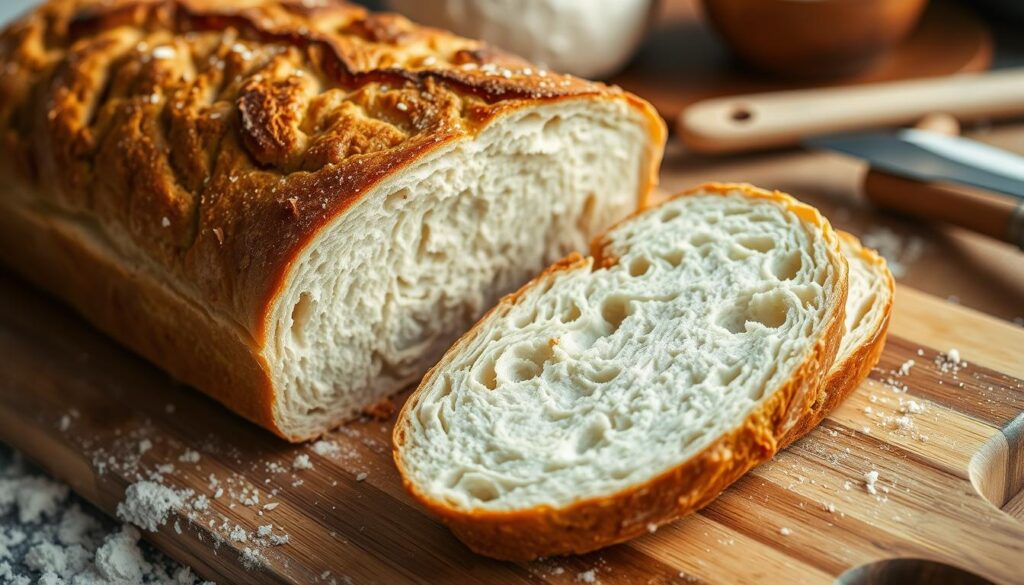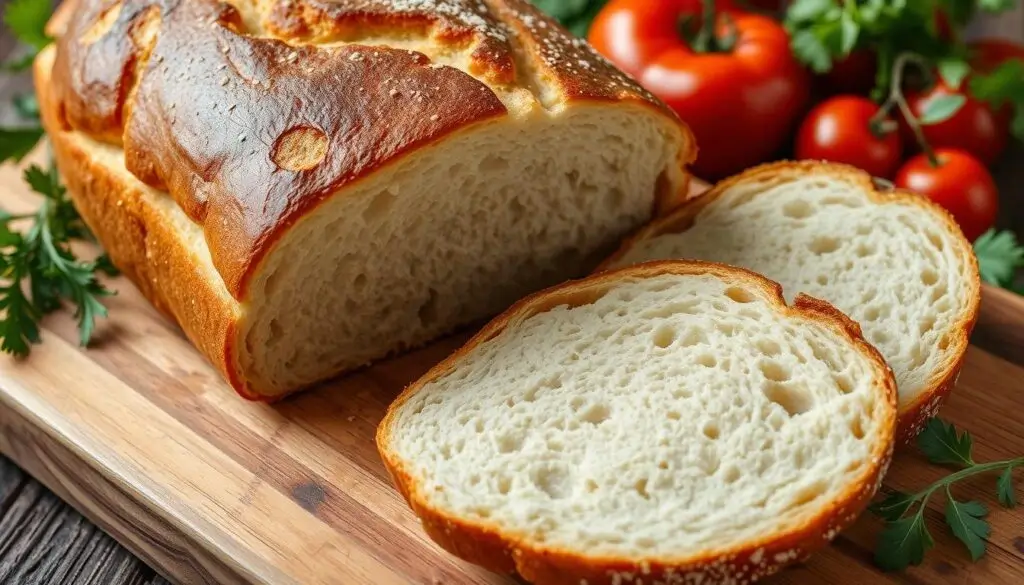Table of Contents
The smell of fresh bread in the kitchen is amazing. The crisp crust and soft inside are perfect. Making homemade sourdough is a joy for me.
I love making artisanal loaves. Today, I’m excited to share how to make the best sourdough sandwich loaf.
This guide will teach you to make a tasty sourdough sandwich loaf bread with your own sourdough starter. You’ll learn how to mix the dough and bake the perfect loaf. You’ll also discover the history and health benefits of sourdough bread.
Whether you’re experienced or new to baking, this article will help you. You’ll learn to make an artisanal loaf that will make your sandwiches better.
What is Sourdough Bread?
Sourdough bread is a special kind of fermented bread loved for centuries. Its unique taste and texture come from a sourdough starter. This starter is a mix of flour and water.
The History and Significance of Sourdough
Sourdough bread’s history goes back thousands of years. It was a key food in ancient Egypt and Greece. In places like San Francisco, the cool, foggy weather was perfect for making sourdough starters.
Now, sourdough is loved for its rich flavor, chewy inside, and crispy outside. The long fermentation process breaks down flour’s starches and proteins. This makes the bread easier to digest and full of nutrients.
Nutritional Benefits of Sourdough Bread
Sourdough bread is not just tasty; it’s also good for you. The fermentation process boosts the availability of vitamins, minerals, and antioxidants. It also has a lower glycemic index than other breads, which is good for blood sugar.
The probiotics in sourdough starters help your gut health. Whether you’re a sourdough fan or new to it, knowing its history and health benefits makes it even more special.
“The true nature of sourdough is a fascinating and complex one, with a history as rich as the bread itself.”
Sourdough Starter: The Foundation of Flavor
At the heart of every great sourdough bread is a thriving sourdough starter. This living culture of wild yeast and beneficial bacteria is key to the bread’s unique flavor and rise. Learn how to create and care for your own sourdough starter. This will ensure you have a reliable leavening agent for your baking.
Creating and Maintaining a Sourdough Starter
Starting a sourdough starter from scratch might seem hard, but with patience and care, you can create a vibrant culture. This culture will be the base for your homemade sourdough bread. Here’s how to start:
- Start with a clean, wide-mouth jar and mix equal parts whole wheat or all-purpose flour and warm water. Stir until it’s thick like batter.
- Cover the jar loosely and let it sit at room temperature for 24 hours. The natural yeasts and bacteria in the flour will start to grow.
- After 24 hours, throw away half of the starter and add equal parts fresh flour and water. Do this once or twice a day for 5-7 days. Your starter will become bubbly, double in size, and smell slightly sour.
- Once your starter is ready, keep it alive by feeding it regularly. Feed it once a day or every other day. Store it at room temperature when using it, and in the fridge when not to slow it down.
Looking after your sourdough starter is a continuous task, but with practice, you’ll get the hang of it. You’ll learn to spot the signs of a healthy starter and find a rhythm for feeding and caring for it.
Remember, a well-cared-for sourdough starter is the key to amazing sourdough bread. Spend the time and effort to grow your own. You’ll be rewarded with delicious, homemade loaves every time.
Ingredients for Sourdough Sandwich Loaf
To make the perfect sourdough sandwich loaf, you need a few key ingredients. Let’s look at what makes this bread so special.
The sourdough starter is at the heart of sourdough bread. It’s a mix of flour and water that gives the bread its tangy taste and rise. Make sure your starter is active and bubbly before you start baking.
You’ll also need all-purpose flour or bread flour to make the dough. The flour amount depends on your loaf’s size. Usually, you’ll use 500-600 grams.
- Sourdough starter
- All-purpose flour or bread flour
- Water
- Salt
The water should be lukewarm, around 90-95°F (32-35°C). This helps the dough proof well. The water amount depends on your starter’s hydration, but it’s usually a 1:1 ratio with flour.
Lastly, add a pinch of salt to boost the flavor and texture of your sourdough sandwich loaf.
| Ingredient | Amount |
|---|---|
| Sourdough starter | 100-150 grams |
| All-purpose flour or bread flour | 500-600 grams |
| Water | 500-600 grams |
| Salt | 10-12 grams |
The exact amounts can change based on your loaf’s size and starter hydration. Always follow a trusted recipe and adjust as needed for the best results.
Equipment Needed for Baking Sourdough
To bake delicious sourdough bread at home, you need the right tools. Knowing the essential items will help you succeed in sourdough baking.
A Dutch oven is crucial for sourdough baking. It traps steam, just like commercial ovens, for a perfect crust. You also need a bread proofing basket, or banneton, to shape and proof your dough.
A dough scraper is great for handling sourdough dough. It lets you shape the dough gently without tearing. A bench scraper is useful for dividing dough and cleaning your work area.
| Essential Sourdough Baking Equipment | Why It’s Important |
|---|---|
| Dutch Oven | Replicates the steam environment of commercial ovens for a perfect crust |
| Bread Proofing Basket (Banneton) | Shapes and proofs the dough, ensuring a beautiful loaf |
| Dough Scraper | Gently handles the delicate sourdough dough without tearing |
| Bench Scraper | Divides and portions the dough, and cleans the work surface |
Getting these sourdough bread baking equipment and tools for baking sourdough is key. With the right tools, you’ll make artisanal sourdough bread at home.

Step-by-Step Guide to Making Sourdough Sandwich Loaf Bread
Making sourdough sandwich loaf is an art that needs patience and detail. This guide will show you how to make a soft, tasty, and textured sourdough bread. It’s perfect for sandwiches.
Mixing the Dough
Start by mixing sourdough starter, warm water, and bread flour in a big bowl. Knead the dough for 10 minutes until it’s smooth and elastic. This step is key for the bread’s chewy texture.
Bulk Fermentation
Put the dough in a greased bowl and cover it. Let it ferment at room temperature for 8 to 12 hours. It should double in size. This step is vital for the bread’s complex flavors.
Shaping and Proofing
Punch down the dough to get rid of air bubbles. Shape it into a rectangular loaf. Put it in a greased loaf pan and cover it. Let it proof for 2 to 4 hours, until it rises a bit.
Baking the Sourdough Loaf
Heat your oven to 450°F (230°C). Score the dough’s top with a knife or lame. Bake for 20 minutes, then lower the heat to 400°F (200°C). Bake for another 25 to 30 minutes, until the crust is golden.
By following these steps, you’ll make a sourdough sandwich loaf that looks great and tastes amazing. Enjoy the journey of sourdough bread baking and relish the delicious outcome.
Sourdough Sandwich Loaf Bread Recipe
Making your own sourdough sandwich loaf bread at home is a fun and tasty journey. This recipe will help you make a soft, yet strong loaf. It’s great for sandwiches, toast, and more. Just follow these steps to make your own homemade sourdough bread easily.
To start, you’ll need these ingredients:
- 300g active sourdough starter
- 600g bread flour
- 360g water
- 12g salt
- 30g honey (optional)
First, mix the dough. In a big bowl, put together the sourdough starter, bread flour, water, and salt. Knead it until it’s smooth and elastic. Add honey if you’re using it.
Then, cover the dough and let it bulk ferment for 8-12 hours. It should double in size. After that, punch it down to get rid of air pockets. Shape it into a tight loaf. Put it in a greased loaf pan and let it proof for 2-3 hours more.
Heat your oven to 450°F (230°C). When the dough is ready, bake it for 30-35 minutes. It should have a deep golden crust. Let it cool completely before slicing and enjoying your sourdough sandwich bread.

Now, you can make a tasty and healthy sourdough sandwich loaf bread at home. Enjoy its rich flavors and texture in your favorite sandwiches and toasts.
Tips for Perfect Sourdough Bread
Baking sourdough bread is a true art form. With the right tips and tricks, you can improve your skills. Whether you’re new or experienced, these expert insights will help you master sourdough bread baking.
- Manage Your Sourdough Starter: Keeping your sourdough starter healthy is key. Feed it regularly, keep it at the right temperature, and discard some before each feeding. This encourages strong fermentation.
- Autolyse for Better Gluten Development: Letting your dough autolyse before kneading improves gluten. This leads to a better rise and chewier texture.
- Tweak Your Baking Process: Adjust baking time, temperature, and humidity to fit your kitchen. Try steam injection or pre-heating your Dutch oven for the perfect crust and crumb.
- Monitor Dough Fermentation: Watch the bulk fermentation and proofing stages closely. These are crucial for developing flavors and structure in your sourdough bread.
- Incorporate Folds and Turns: Do gentle folds and turns during bulk fermentation. This strengthens the dough’s gluten and makes the crumb more even.
| Tip | Benefit |
|---|---|
| Manage Your Sourdough Starter | Ensures a healthy, active starter for optimal fermentation |
| Autolyse for Better Gluten Development | Improves dough structure and rise |
| Tweak Your Baking Process | Allows you to adapt to your specific kitchen conditions |
| Monitor Dough Fermentation | Develops complex flavors and optimal crumb structure |
| Incorporate Folds and Turns | Strengthens gluten structure for a more even crumb |
By using these tips for baking sourdough bread, you’ll make great sourdough bread every time. Enjoy experimenting and adjust your techniques to fit your taste and kitchen.
“Baking sourdough bread is a journey of patience, experimentation, and a deep appreciation for the art of fermentation.”
Troubleshooting Common Sourdough Issues
Starting your sourdough baking journey can come with some challenges. You might face sticky dough, dense, or gummy crumb issues. Don’t worry, we have effective solutions for these troubleshooting sourdough bread problems.
Dealing with Sticky Dough
Sticky dough can be frustrating. But, with a few tweaks, you can get it to a better consistency. Here are some tips to fix sourdough bread problems like sticky dough:
- Add a bit more flour to your recipe, adjusting as you go until the dough feels right.
- Do more kneading or stretching and folding during bulk fermentation to strengthen the dough.
- Let the dough rest for 30 minutes to an hour before shaping. This helps the flour hydrate fully.
Preventing a Dense or Gummy Crumb
A dense or gummy crumb is a common sourdough bread issue. Here’s how to troubleshoot sourdough bread problems and avoid it:
- Make sure your sourdough starter is active and healthy. It’s key for a good rise and fermentation.
- Start with a bit less water in your dough and add more if needed.
- Bake your loaf at a higher temperature (around 450°F). This helps with a better rise and crumb.
Fixing common sourdough bread issues takes some trial and error. But with these tips, you’ll soon be making perfect sourdough loaves every time.
Variations and Flavor Combinations
Make your sourdough sandwich loaf even better by trying new flavors and add-ins. You can go for savory or sweet, and there’s no limit to what you can do with your homemade sourdough bread.
Try adding savory herbs and spices to your dough. Rosemary, thyme, oregano, or Italian seasonings can give it a rich, earthy taste. For a cheesy flavor, mix in shredded cheddar, parmesan, or crumbled feta before shaping.
If you like sweet things, add dried fruits, nuts, or chocolate chips. Chopped apricots, cranberries, or raisins add sweetness. Toasted walnuts, pecans, or almonds give a nice crunch. Dark chocolate chips make it a special treat.
Sourdough bread is very versatile. Try different flavors to find what you like best. Whether you prefer savory or sweet, you can customize your sourdough sandwich loaf however you want.
“The secret to great sourdough is in the flavor combinations. Don’t be afraid to get creative with your add-ins!”
Sourdough Bread Add-In Ideas
- Herbs: rosemary, thyme, oregano, Italian seasoning
- Cheese: cheddar, parmesan, feta
- Dried fruits: apricots, cranberries, raisins
- Nuts: walnuts, pecans, almonds
- Chocolate chips
Storing and Enjoying Sourdough Bread
Keeping your sourdough bread fresh is all about the right storage. Whether you’re eating it right away or saving it, knowing how to store it is crucial. This way, you can enjoy its delicious taste for longer.
Storing Sourdough Bread
To keep your sourdough bread fresh, follow these steps:
- Let the bread cool completely before storing to prevent moisture buildup.
- Wrap the loaf tightly in a paper bag or dish towel, avoiding plastic bags which can trap moisture and cause the crust to soften.
- Store the wrapped bread at room temperature, away from direct sunlight or heat sources, for up to 4 days.
- For longer storage, slice the bread and freeze it in an airtight container or resealable bag for up to 3 months.
Enjoying Sourdough Bread
Sourdough bread is perfect for many tasty dishes. Here are some ideas to get you started:
- Toast thick slices and top with your favorite spreads, such as butter, jam, or avocado.
- Use the bread for hearty sandwiches, layering it with meats, cheeses, and fresh veggies.
- Cube the bread and toss it into salads for a satisfying crunch.
- Bake the bread into French toast or bread pudding for a comforting breakfast or dessert.
| Storage Method | Duration |
|---|---|
| Room temperature (wrapped in paper bag or dish towel) | Up to 4 days |
| Frozen (sliced and stored in airtight container or bag) | Up to 3 months |
Enjoying your homemade sourdough bread is all about proper storage and creativity. With a bit of care and imagination, you can enjoy its unique taste and texture for days.
Conclusion
In this guide, you’ve learned how to make a great sourdough sandwich loaf at home. You now know the history and benefits of sourdough. Plus, you’ve got the skills to bake it yourself.
Baking sourdough bread takes patience and practice, but it’s worth it. This sourdough sandwich loaf recipe is a great starting point. It helps you make amazing loaves every time.
The journey of sourdough baking is just as rewarding as the bread itself. Enjoy the process, learn from your mistakes, and feel proud of your creations. Happy baking!


4 thoughts on “Sourdough sandwich loaf bread recipe”